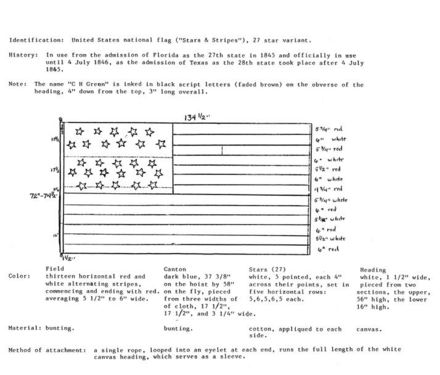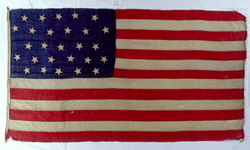

Obverse - 2

Obverse
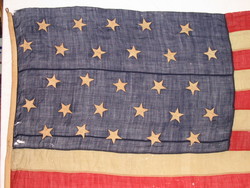
OBVERSE Detail

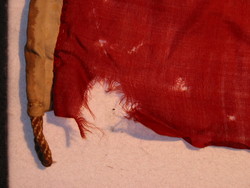
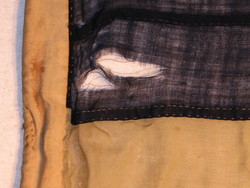
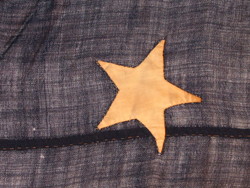


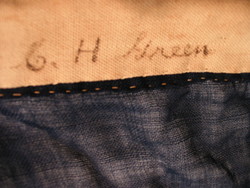


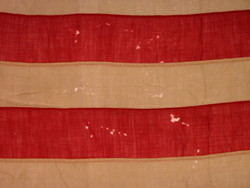
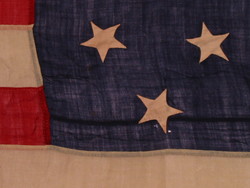

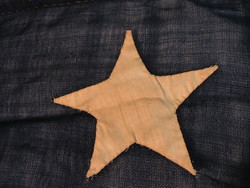
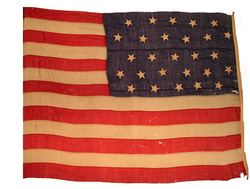
Reverse

Book Photo
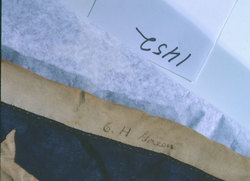
Hoist Detail

H. Madaus & this flag
U.S. 27 Star Military Storm Flag, 1845-1846.
Sub-collection: Howard M. Madaus - Civil War & 19th Century Military Collection27 Stars U.S. Military Storm Flag - Florida's admission into the Union March 3, 1845.
This period example 27 Star United States flag was made to indicate the admission of Florida as the 27th state to the Union. Florida Territory, which the United States purchased from Spain in 1819, achieved statehood on March 3rd, 1845. The star representing Florida was officially added to the union in the United States flag on July 4th of that year. However, on December 29th, 1845, Texas was admitted as the 28th state. Accordingly the 27-star flag became obsolete on July 4th of 1846, thus 27 star flags are quite rare. This flag bears the inked name "C.H. Green" inscribed on its white canvas heading. This is likely the owner of the flag or the name of the individual who originally purchased it.
Twenty-seven star flags represent the ninth official and the 16th actual, version of the United States flag, and was the official U.S. flag at the outbreak of the War with Mexico and the flag's size and materials suggest a military storm flag; or possibly a ship's ensign.
It is 74" on the hoist by 134" on the fly (overall), consisting of a field of thirteen alternating horizontal red and white wool bunting stripes, varying in width from 5 1/2" to 6", sewn together by hand, with a dark blue wool bunting canton, 37" on the hoist by 38" on the fly, formed from three pieces (17 1/2", 17 1/2" and 3 1/4" wide) of bunting joined by hand horizontally and inset into the field of stripes so as to extend through the seventh (from the top) stripe. The canton bears twenty-seven (27) white cotton, five-pointed stars, each measuring about 4" across their points, appliquéd to each side of the canton by hand and set in five horizontal staggered rows: 5, 6,5,6,5. White canvas heading formed into a sleeve, 1 1/2" wide when flat, encompasses as a single hemp rope extended at each end and knotted into a rope eyelet for attaching to a halyard. The heading bears the inked name "C H Green", likely the purchaser, or a previous owner of the flag.
The Howard Michael Madaus sub-collection of Civil War Military Flags was assembled from a variety of sources over a thirty year period of collecting (1970-2000) before being acquired by the Zaricor Collection in 2000. The sub-collection attempts to present an example of each of the major types of depot contractor regulation flags and colors carried by Union forces at the basic unit level, i.e. regiment, battalion, company, and battery, as well as the types of general military flags.
This sub-collection (Howard Michael Madaus collection) added to the Zaricor Civil War collection is the largest and (while not complete) most comprehensive collection of the military flags carried by the Union Army during the Civil War outside of state repositories designated by the War Department for the disposition of these flags after the War or in public museum collections. In fact this private collection is larger and more comprehensive than many of the public museum collections in the United States.
Exhibition History:
Flag was exhibited at the 1996 meeting of North American Vexillological Association, Sacramento, CA.
It was used in the presentation by Howard M. Madaus.
First Presidio Exhibit, 2003
Twenty-Seven-Star United States Flag
Second Presidio Exhibit, 2003 Gallery II
27-Star United States Flag
Publication History:
Madaus, Howard M., Dr, Whitney Smith, The American Flag: Two Centuries of Concord and Conflict. Santa Cruz: VZ Publications, 2006, p. 43
Provenance:
• C.H. Green, 19th century.
• Acquired by Hank Ford, Bedford, NH, 1995.
• Acquired Zaricor Flag Collection via Howard M. Madaus, Cody, WY in 1972.
ZFC Significant Flag
Item is Framed
Sources:
Collins, Herbert Ridgeway, Threads of History, Americana Recorded on Cloth 1775 to the Present, City of Washington, Smithsonian Press, 1979.
Cooper, Grace Rogers, Thirteen-Star Flags: Keys to Identification, Smithsonian Institution Press, City of Washington, 1973.
Madaus, Howard M.- Whitney Smith, The American Flag: Two Centuries of Concord and Conflict, VZ Publications, Santa Cruz, 2006.
Madaus, Howard M., letter to Ben Zaricor, 16 November 1995, Zaricor Flag Collection Archives.
Mastai, Boleslaw and Marie-Louise D'Otrange, The Stars and The Stripes: The American Flag as Art and as History from the Birth of the republic to the Present, Knopf, New York, 1973.
27 Star Flag - (1845-1846) (U.S.), Flags of the World, 11 November 2011, from: http://www.crwflags.com/fotw/flags/us-1845.html
Image Credits:
Zaricor Flag Collection
Hoist & Fly | |
|---|---|
| Width of Hoist | 74 |
| Length of Fly | 134 |
Union/Canton | |
|---|---|
| Width of Union/Canton | 38.6 |
| Length of Union/Canton | 53 |
Stars | |
|---|---|
| Comments on Star Measurements | 5-6-5-6-5 pattern |
| Size of Stars | 4 |
Stripes | |
|---|---|
| Width of 1st Stripe | 5 |
| Width of 3rd Stripe | 5 |
| Width of 8th Stripe | 5.75 |
| Width of Last Stripe | 6.5 |
| Size of Hoist | 1.75 |
Frame | |
|---|---|
| Is it framed? | yes |
| Frame Height | 83 |
| Frame Length | 147 |
Stars | |
|---|---|
| Number of Stars | 27 |
| How are the stars embeded? | Sewn |
| Are there stars on obverse? | yes |
| Are there stars on reverse? | yes |
| Star Pattern | 5-6-5-6-5 pattern |
Stripes | |
|---|---|
| Number of Stripes | 13 |
| Color of Top Stripe | Red |
| Color of Bottom Stripe | Red |
| Has a Blood Stripe? | no |
Nationality | |
|---|---|
| Nation Represented | United States |
Fabric | |
|---|---|
| Fabric | Wool |
| Comments on Fabric | Bunting |
Stitching | |
|---|---|
| Stitching | Hand |
Thread | |
|---|---|
| Type of Thread | Needs Analysis |
| Thread Material | Needs Analysis |
Weave | |
|---|---|
| Type of Weave | Plain |
Attachment | |
|---|---|
| Comments on Method of Attachmen | Rope through header |
| Method of Attachment | Roped-header |
Applica | |
|---|---|
| Applique Sides | Single Faced = Mirror Image Reverse |
Condition | |
|---|---|
| Condition | Good |
| Damage | Moth Holes |
| Displayable | yes |
Date | |
|---|---|
| Date | circa 1845 |
Exhibits | |
|---|---|
| Exhibition Copy | Exhibition History Flag was used at the 1996 North American Vexillological Association, Sacramento, CA. It was used in the presentation by Howard Madaus. First Presidio Exhibit (ZFC1452) TWENTY-SEVEN-STAR UNITED STATES FLAG Date: 1845-1846 Media: Wool bunting with cotton stars; all hand sewn Comment: Florida Territory, which the United States purchased from Spain in 1819, achieved statehood on March 3rd, 1845. The star representing Florida was officially added to the union in the United States flag on July 4th of that year. However, on December 29th, 1845, Texas was admitted as the 28th state. Accordingly the 27-star flag became obsolete on July 4th of 1846. This flag bears the inked name C.H. Green inscribed on its white canvas heading. This is likely the owner of the flag or the name of the individual who originally purchased it. At nearly six feet by eleven feet, it is likely that this was a merchant ship's ensign. Provenance: Acquired by the Zaricor Flag Collection (ZFC1452) in 1995 from Hank Ford of Bedford, New Hampshire. Second Presidio Exhibit, 2003 Gallery II (ZFC1452) 27-Star United States Flag Date: 1845-1846 27 Stars: July 4, 1845-July 3, 1846 (Florida statehood March 3, 1845) Media: Wool bunting with cotton stars; hand-sewn Comment: The Territory of Florida, which the United States had purchased from Spain in 1819, achieved statehood on March 3rd, 1845. The star representing the new state was officially added to the union of the United States flag on July 4th of that year. However, since Texas was admitted as the 28th state later that same year, the 27-star flag became obsolete on Independence Day in 1846. This particular flag bears the inked name C.H. Green inscribed on its white canvas heading. He is likely to have been the original owner of the flag or an individual who later acquired it. At nearly six feet by eleven feet, it is likely that this was utilized as a merchant ship ensign. Provenance: Acquired by the Zaricor Flag Collection (ZFC1452) in 1995 from Hank Ford of Bedford, New Hampshire. H. Madaus notes: Twenty-seven star flags represent the ninth official version of the United States flag, consequent to the inclusion of Florida as the 27th state, admitted to the Union on 3 March 1845 and official (in accordance with the 1818 flag act) on 4 July 1845. This was the official U.S. flag at the outbreak of the War with Mexico and became "obsolete" with the admission of Texas to the Union on 29 December 1845 (with the 28 star flag becoming official on 4 July 1846.) The flag's size and materials suggest a military camp or recruiting flag or a ship's ensign. 74" hoist by 134" fly (overall), consisting of a field of thirteen alternating horizontal red and white wool bunting stripes, varying in width from 5 1/2" to 6", sewn together by hand, with a dark blue wool bunting canton, 37" on the hoist by 38" on the fly, formed from three pieces (17 1/2", 17 1/2" and 3 1/4" wide) of bunting joined by hand horizontally and inset into the field of stripes so as to extend through the seventh (from the top) stripe. The canton bears twenty-seven (27) white cotton, five-pointed stars, each measuring about 4" across their points, appliqued to each side of the canton by hand and set in five horizontal staggered rows: 5,6,5,6,5. White canvas heading formed into a sleeve, 1 1/2" wide when flat, encompasses as a single hemp rope extended at each end and knotted into a rope eyelet for attaching to a halyard. The heading bears the inked name "C H Green". |
Publications | |
|---|---|
| Publication Copy | Publication History: Madaus, Howard M., Dr, Whitney Smith, The American Flag: Two Centuries of Concord and Conflict. Santa Cruz: VZ Publications, 2006, p. 43. 27-Star United States Flag The Territory of Florida, which the United States had purchased from Spain in 1819, achieved statehood on March 3rd, 1845. The star representing the new state was officially added to the union of the United States flag on July 4th of that year. However, since Texas was admitted as the 28th state later that same year, the 27-star flag became obsolete on Independence Day in 1846. This particular flag bears the inked name C.H. Green inscribed on its white canvas heading. He is likely to have been the original owner of the flag or an individual who later acquired it. At nearly six feet by eleven feet, it is likely that this was utilized as a merchant ship ensign. In 1846 the United States, under the leadership of James K. Polk, went to war with Mexico, and the American settlers in California proclaimed the Bear Flag Republic shortly before United States naval officers seized the area. The American star was used as a symbol on both the Texas and California flags. |

